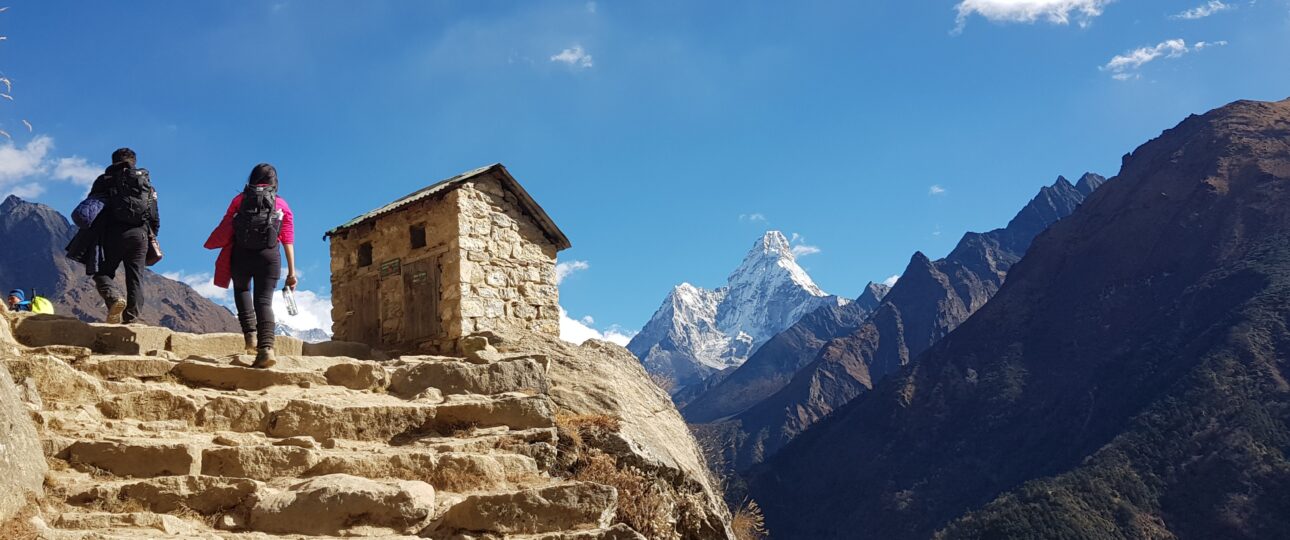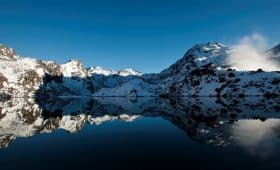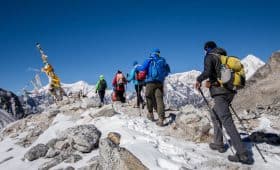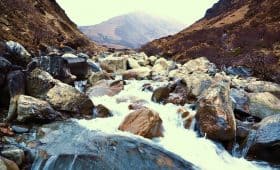Everest Base Camp Trek is one of the most incredible trekking experiences in the world. EBC trek is known for its closeness to Mount Everest, the world’s tallest mountain, which rises to 8,848.86 meters (29,031.7 feet). How to trek to Everest Base Camp is not just about reaching a specific place, but it is a journey full of history, culture and the majestic beauty of the Himalayas.
Trek to Everest Base Camp has a long history, starting with early explorers in the 1920s. The journey became famous when Tenzing Norgay and Edmund Hillary reached the summit of Mount Everest in 1953. Since then, many people have taken the trek for its stunning views and the achievement of reaching the base of the world’s highest mountain.
What makes the EBC trek unique is the entire journey. Before the trek begins, you arrive in Kathmandu, a city rich in culture and life. It’s a great introduction to Nepal.
The actual trek starts in Lukla, a town in the Khumbu region. From there, you walk through beautiful Sherpa villages like Namche Bazaar and Tengboche.
As you go higher, you’ll see different landscapes, from lush forests and rhododendron groves to icy moraines and mountainous areas. You’ll be greeted by the friendly Sherpa people known for their kindness and resilience.
The trek is not just about the mountains. It’s also about the friendships you make with other trekkers and the connections you build with your guides and porters.
From local teahouses with warm meals to watching the sunrise over the Himalayas, every moment is special.

Trekking to EBC is also a journey of personal growth. As you adapt to the altitude and tackle challenging trails, you’ll push your limits and discover your inner strength. The peaceful silence of the mountains gives you space to think and appreciate the beauty of nature.
For those new to trekking to Everest Base Camp, planning might seem challenging. But with the right preparation and guidance, it can be an adventure of a lifetime.
This beginner’s guide aims to simplify the planning process and answer common questions, helping you start this unforgettable journey with confidence.
Whether you are drawn to the adventure of trekking through the Himalayas, the chance to see the iconic Khumbu Icefall, or the opportunity to stand at the base of Mount Everest, trekking to Everest Base Camp promises to be a life changing experience. Let this guide help you prepare for your own Everest Base Camp adventure. Happy trekking to EBC!
Table of Contents
- How to Trek to Everest Base Camp: Planning and Preparation
- The Everest Base Camp Trek from Kathmandu
- Frequently Asked Questions
- Where is Everest Base Camp?
- What is the most beautiful part of the Everest Base Camp Trek?
- Why is Everest Base Camp trek so special?
- Is EBC trek very expensive?
- Is EBC part of Nepal or China?
- Does it snow in Everest Base Camp?
- Are there people living in Everest Base Camp?
- Do people speak English along the teahouses at Everest Base Camp trek?
- Is there a place to have some nightlife along the EBC trail?
- How do I go from Kathmandu to Everest Base Camp?
- Kathmandu to Mount Everest Distance: How Far?
- Can you take a bus to Everest Base Camp?
- Where do you start to get to Everest Base Camp?
- Is there a train from Kathmandu to Everest Base Camp? How to reach/travel to Mount Everest Base Camp from Kathmandu?
- What I wish I knew before trekking to EBC?
- In Conclusion:
How to Trek to Everest Base Camp: Planning and Preparation
Proper planning and preparation are key to a successful trek to Everest Base Camp. Trekking to Everest Base Camp requires careful and thorough planning to ensure a safe and successful journey. Considering the following factors will help you make the most out of your adventure to EBC.
Choose a Reliable Operator
It’s mandatory to work with a locally registered tour company when trekking to EBC. Choose an operator that provides experienced guide, porter, accommodations, meals and permits. A trustworthy and the best EBC trek operator prioritizes your safety and enjoyment over cutting costs.
Look for companies with positive reviews and a commitment to ethical practices such as fair wages for porters and guides, adherence to environmental policies and responsible tourism. Such operators can enhance your overall experience by providing valuable insights into the region’s culture and natural wonders.
Timing Matters
The best times to trek to EBC are during the pre-monsoon season (March to May) and post-monsoon season (September to November). These months offer the most favorable weather, with clear skies, moderate temperatures and stunning mountain views.
We often receive questions such as, Can I do the Everest Base Camp trek in September?, The answer is yes; you can trek to Everest Base Camp in September. In fact, it is one of the best months to avoid crowds and enjoy the beginning of the main trekking season.
However, trekking during other months is also possible, though it requires careful consideration of potential weather challenges and fewer clear days. Always check weather forecasts and be prepared for changing conditions.
Book Your Flights
Fly into Kathmandu, where you’ll begin your journey to the base camp. Plan to spend a couple of days in the city both before and after your trek to account for potential delays in Lukla flights. These buffer days are crucial for acclimatization and any unexpected itinerary changes.
Get in Shape
Trekking to EBC is a physically demanding journey that requires stamina and endurance. Prepare yourself for successful EBC trek by doing cardio exercises, hiking and carrying a weighted backpack in the months leading up to your trek. Building your strength and endurance will make the journey more enjoyable and less strenuous.
Travel Light
When packing for your trek, take only the essentials. Every extra item adds unnecessary weight to your backpack and can slow you down on the trail. Prioritize multi-functional clothing and gear and pack layers to adapt to varying temperatures.
Respect Your Feet
Invest in quality footwear for your trek. Choose comfortable hiking boots that offer support and stability on rough terrains. All terrain trainers can be useful for their quick-drying capabilities, especially after walking through streams or wet conditions.
Protect Your Knees
Using trekking poles can help you manage steep descents and provide additional support on the trail. They can reduce the strain on your knees and joints, making the journey more comfortable and safe.
Climb Slowly
The key to avoiding Acute Mountain Sickness (AMS) is to ascend gradually and allow time for acclimatization. Rest days are essential at higher altitudes to let your body adjust to the thin air. Listen to your body and take it slow to stay healthy.
Buffer Days
Flights to and from Lukla can be subject to cancellations due to unpredictable weather conditions. Plan for a few extra days at the end of your trek in case of flight delays. These buffer days provide flexibility and peace of mind in case your schedule needs to adjust.
Travel Insurance
You have booked your trip, secured flights to Kathmandu and prepared yourself physically and mentally. But don’t forget to get travel insurance for your Everest Base Camp trek. Altitude sickness can happen to anyone, even with good preparation. With good travel insurance, you can be quickly taken by helicopter to a hospital in Kathmandu if you get sick. This coverage ensures you stay safe during your adventure.
Want more information? Send us your query, and our experts will get back to you within 24 hrs.
The Everest Base Camp Trek from Kathmandu
To complete the Everest Base Camp Trek from Kathmandu, here are some key pieces of information you will need.
Flight to Kathmandu and Back
Book a flight that aligns with your schedule and preferences to arrive in Kathmandu for your booked trek. Choose a reputable operator offering good deals and minimal layovers, as there are few direct flights to Kathmandu from most major cities worldwide.
Starting Point
The journey to Everest Base Camp begins with a short flight from Kathmandu to Lukla, a small town known as the gateway to the Khumbu region and the starting point for your trek. The flight is often exhilarating, offering breathtaking aerial views of the Himalayan landscape.
Once you land in Lukla, you’ll set off on well marked trails, following the Dudh Koshi River through several picturesque villages such as Phakding, Namche Bazaar and Tengboche. This stretch from Lukla to Everest Base Camp introduces you to the enchanting Sherpa culture and the beautiful, diverse scenery of the region.
Itinerary
A typical itinerary for the Everest Base Camp trek spans 14 days, including 2 nights in Kathmandu and 11 days of trekking with time allocated for acclimatization and exploration.
Each day brings its own unique experiences, from lush valleys and terraced fields to rugged mountain paths and stunning vistas.
Day 1: Arrive in Kathmandu and attend a pre-trek meeting in the evening, where you’ll receive important information and have the opportunity to ask questions.
Day 2: After breakfast, take a morning flight to Lukla. From Lukla, your trek begins with a walk to Phakding, a journey of approximately 3.5 hours. Enjoy the scenic trail along the Dudh Koshi River.
Day 3: The trek continues to Namche Bazaar, taking around six hours. Namche is a vibrant Sherpa town with a bustling market, great restaurants and amazing views of the surrounding mountains.
Day 4: Acclimatization day in Namche Bazaar. This is a rest day to adjust to the altitude. Take a side trip to a higher elevation for practice and better acclimatization.
Day 5: Trek to Tengboche, a journey of about five hours. Tengboche is home to a famous monastery, offering panoramic views of Everest, Ama Dablam and other peaks.
Day 6: Trek to Dingboche, a scenic five-hour walk through rhododendron forests and stone-walled pastures. You’ll notice the terrain becoming more barren as you ascend.
Day 7: Rest and acclimatization day in Dingboche. Explore the village and its surroundings while allowing your body to adapt to the high altitude.
Day 8: Continue your journey with a five-hour trek to Lobuche, which offers spectacular views of the surrounding peaks and glaciers.
Day 9: Today is the highlight of the trek as you make your way to Everest Base Camp. After reaching the base camp, take time to soak in the incredible scenery and sense of achievement before returning to Gorak Shep for the night.
Day 10: Rise early for a sunrise hike to Kala Patthar (5,545 meters) to catch breathtaking views of Everest and the surrounding mountains. Afterward, trek down to Pheriche, a journey of approximately seven hours.
Day 11: Retrace your steps back to Namche Bazaar, a journey of about six hours, where you can relax and reflect on your adventure.
Day 12: Continue your return journey to Lukla, taking around six hours. Celebrate the completion of your trek with your guides and porters.
Day 13: Fly back to Kathmandu and transfer to your hotel. Enjoy your time in Kathmandu, reflecting on your incredible journey.
Day 14: Departure day or consider extending your stay in Nepal for more sightseeing or relaxation.
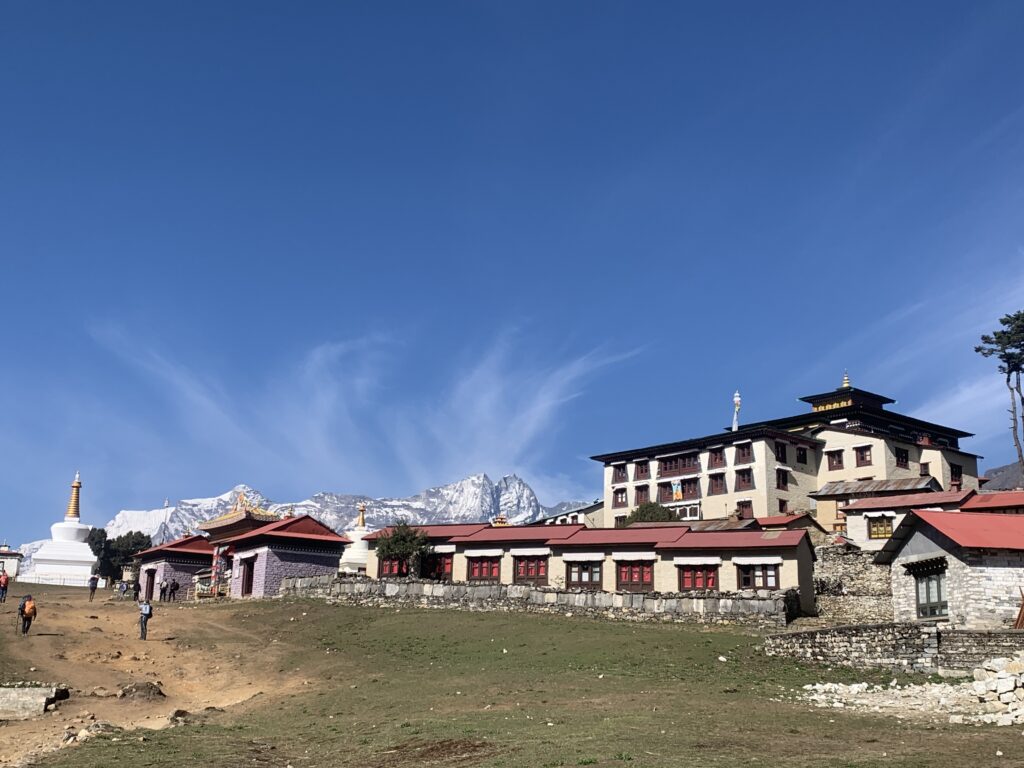
Acclimatization and Safety
Acclimatization is key to a safe and enjoyable trek. Keep extra day in Namche Bazaar and Dingboche to help your body adjust to the altitude.
Use these days to explore the surroundings and take short hikes to higher elevations before returning to your base. This will help you prevent Acute Mountain Sickness (AMS).
It’s essential to listen to your body and your guide’s advice. Climb slowly and take breaks when needed. Stay hydrated and be mindful of any symptoms of altitude sickness, such as headaches or dizziness.
What to Pack
Your EBC Trek packing list should include essentials for varying weather conditions on EBC trek along with altitudes:
- Layered clothing to manage temperature changes, including base layers, a mid-layer and an outer shell.
- A warm jacket and thermal underwear for cold nights and mornings.
- Hiking boots that offer ankle support and are well broken-in for comfort.
- Trekking poles to assist on steep descents and provide stability.
- Hat, gloves and sunglasses to protect against sun, wind and cold.
- A backpack to carry daily essentials such as snacks, water and extra clothing.
- A first aid kit with basic supplies for minor injuries or illnesses.
- Water purification tablets for safe drinking water.
- Hig -energy snacks for extra nourishment on the trail.
Being Responsible: Leave No Trace
As you trek through the beautiful Khumbu region, it’s essential to practice Leave No Trace principles:
Respect local culture: The trek passes through Sherpa villages with unique traditions and customs. Take the time to learn from and interact with the locals, showing respect and appreciation.
Support the local economy: Buy locally made products, crafts and use local services to benefit the community and preserve the culture.
Pack out what you pack in: Dispose of waste properly and minimize your impact on the environment.
Frequently Asked Questions
Where is Everest Base Camp?
Everest Base Camp (EBC) is located in the Khumbu region of Nepal. It is situated on the south side of Mount Everest, within Sagarmatha National Park, a UNESCO World Heritage Site. The base camp serves as the starting point for climbers attempting to summit Mount Everest from the south side.
The exact coordinates of the base camp are approximately 27.98°N latitude and 86.92°E longitude. It sits at an elevation of approximately 5,364 meters (17,598 feet) above sea level.
The trek to Everest Base Camp begins with a flight from Kathmandu to Lukla, followed by a multi day trek through the Khumbu region. The journey takes you through picturesque villages such as Namche Bazaar and Tengboche and stunning natural landscapes, including glaciers, mountains and forests, before reaching the base camp.
What is the most beautiful part of the Everest Base Camp Trek?
The most beautiful part of the Everest Base Camp trek varies depending on personal preference, but several highlights stand out. Namche Bazaar offers panoramic views of mountains like Thamserku and Kongde Ri and is the cultural heart of the Khumbu region with Sherpa hospitality.
Tengboche Monastery is set against a stunning backdrop of peaks, including Everest and Ama Dablam and offers serene and breathtaking views.
The Khumbu Icefall showcases nature’s power with its shifting ice and crevasses, while Kala Patthar provides magnificent views of Everest and the Khumbu Icefall.
Reaching Everest Base Camp is a major achievement, surrounded by the surreal beauty of glaciers and mountains. Throughout the trek, the journey immerses you in stunning landscapes, charming villages and Sherpa culture, making it a captivating experience.
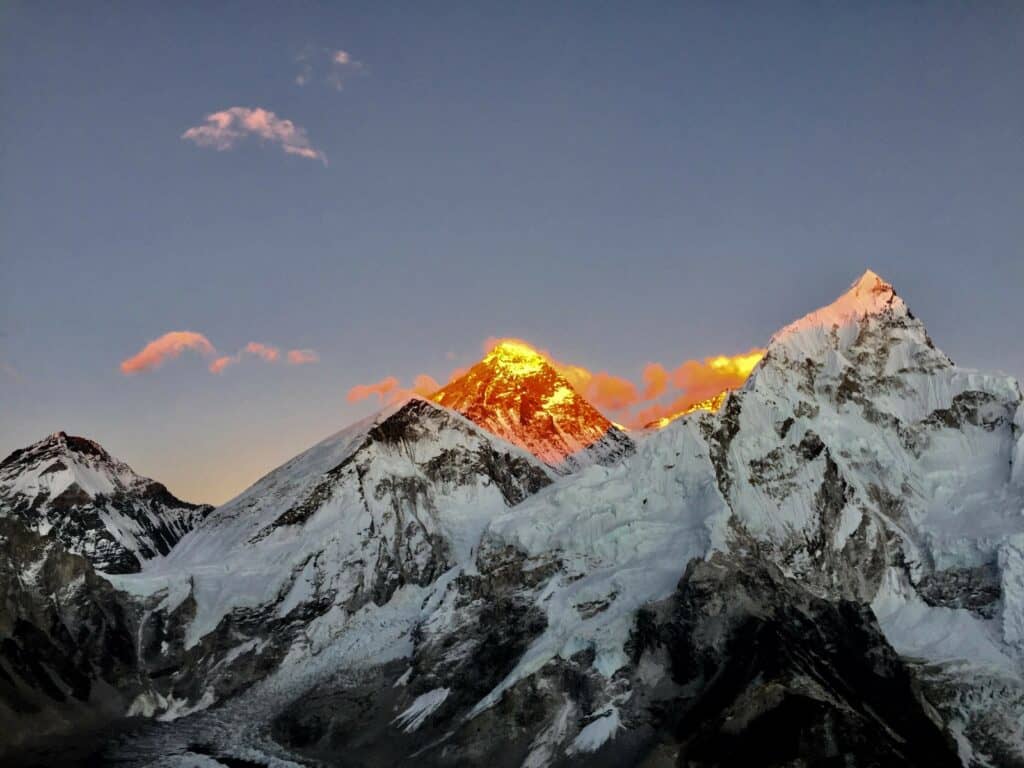
Why is Everest Base Camp trek so special?
The Everest Base Camp trek is special because it offers breathtaking proximity to Mount Everest, stunning scenery and immersive experiences with Sherpa culture. The trek challenges you physically and mentally, rewarding you with a sense of accomplishment and personal growth.
It follows the path of legendary mountaineers, providing historical significance and camaraderie with fellow trekkers. The trek’s diverse landscapes, including glaciers, valleys and forests, make it a truly unforgettable adventure.
Is EBC trek very expensive?
The EBC trek itself can be considered reasonably priced given its duration. For example, tour operators like us offer a 14-day tour for USD 1,445 per person, which includes nearly everything. However, the overall cost can increase due to the flight expenses needed to get to Kathmandu.
Is EBC part of Nepal or China?
Everest Base Camp (EBC) is part of Nepal, located on the southern side of Mount Everest within the Sagarmatha National Park in the Khumbu region. Although there is an Everest Base Camp on the Chinese side of the mountain, people typically don’t trek there as they do in Nepal.
Does it snow in Everest Base Camp?
Yes, it can snow in Everest Base Camp. The base camp is situated at a high elevation of approximately 5,364 meters (17,598 feet) above sea level, where snow is common, particularly during the winter months (December to February).
The weather can be unpredictable, so trekkers should be prepared for the possibility of snow at any time of the year, especially at higher altitudes.
Are there people living in Everest Base Camp?
No, there are no permanent residents living in Everest Base Camp. The base camp is primarily used as a staging area for mountaineers preparing to climb Mount Everest and for trekkers visiting the area.
During the climbing season (spring and fall), the base camp becomes a bustling hub with temporary campsites set up by expeditions groups. However, these camps are dismantled at the end of the season and the area remains uninhabited for the rest of the year.
Do people speak English along the teahouses at Everest Base Camp trek?
Yes, many locals and teahouse operators speak English.
Is there a place to have some nightlife along the EBC trail?
Nightlife along the Everest Base Camp trail is quite limited compared to urban areas. The trail primarily consists of small villages with tea houses and lodges catering to trekkers. In these accommodations, you can find cozy dining areas where trekkers gather in the evenings to share meals, stories and enjoy warm drinks.
While you may find occasional entertainment such as music or games in the larger villages like Namche Bazaar and Lukla, the overall atmosphere tends to be more relaxed and focused on resting and preparing for the next day’s trek.
Namche Bazaar and Lukla, being larger towns, have a few bars and cafes where you might find some social activities in the evenings. However, the trail is not known for its nightlife and most trekkers prefer to rest and sleep early to stay healthy and energized for the journey ahead.
How do I go from Kathmandu to Everest Base Camp?
Fly from Kathmandu to Lukla and start trekking from there.

Kathmandu to Mount Everest Distance: How Far?
The distance from Kathmandu to Mount Everest, as the crow flies, is approximately 160 kilometers (100 miles). However, the actual trekking distance to reach Everest Base Camp is much longer.
The trekking route from Lukla (the starting point of the trek) to Everest Base Camp is about 65 kilometers (40 miles) one way, making the total round-trip distance approximately 130 kilometers (80 miles).
Can you take a bus to Everest Base Camp?
No, there is no road access. The trek starts with a flight to Lukla.
Where do you start to get to Everest Base Camp?
The trek starts in Lukla.
Is there a train from Kathmandu to Everest Base Camp? How to reach/travel to Mount Everest Base Camp from Kathmandu?
No, there is no train service from Kathmandu to Everest Base Camp. The main way to reach EBC from Kathmandu is by taking a flight to Lukla and then trekking to EBC and back.
The trek involves walking along well marked trails that pass through various villages, valleys and mountainous terrain on the way to Everest Base Camp.
What I wish I knew before trekking to EBC?
Before trekking to Everest Base Camp (EBC), it’s important to understand the significance of acclimatization to prevent altitude sickness and to prepare physically for the challenging trek.
Packing light with only essentials will make the journey easier and being aware of the unpredictable weather can help you pack appropriately. A good guide can enhance your experience by providing navigation and cultural insights.
Having cash on hand is essential as many places along the trail don’t accept cards. Staying hydrated and eating well will maintain your energy levels. Respecting the local culture and environment by adhering to Sherpa traditions and minimizing your impact is vital.
Allow for buffer days in your schedule as flights to Lukla can be delayed due to weather.
Finally, remember to walk slowly and take your time to enjoy the trek and acclimatize properly. Being prepared for these aspects will enhance your overall experience.

In Conclusion:
The Everest Base Camp (EBC) trek is a journey of a lifetime, offering breathtaking proximity to Mount Everest and an immersive experience in the culture of the Himalayas. The journey begins with a flight to Lukla from Kathmandu and follows a multi-day trek through picturesque villages, valleys and mountainous terrain.
Trekkers can experience the unique Sherpa culture and enjoy stunning views of the Khumbu Icefall, glaciers and peaks like Ama Dablam.
Proper planning is essential for a successful trek, including securing the right permits, choosing a reputable operator and preparing physically.
The trek spans approximately 14 days, including time for acclimatization, with a diverse itinerary that includes resting in vibrant towns like Namche Bazaar.
Packing light, staying hydrated and being aware of the weather are important aspects of the trek. Although the journey is challenging, the sense of accomplishment, natural beauty and cultural encounters make the EBC trek a truly unforgettable adventure.
Thank you for reading our comprehensive guide on How to Trek to Everest Base Camp.
If you are looking to book an EBC trek and need a reliable operator, please contact us, Mosaic Adventure, a local operator organizing EBC treks for 15 years. Let us help you embark on this amazing journey!
Want more information? Send us your query, and our experts will get back to you within 24 hrs.
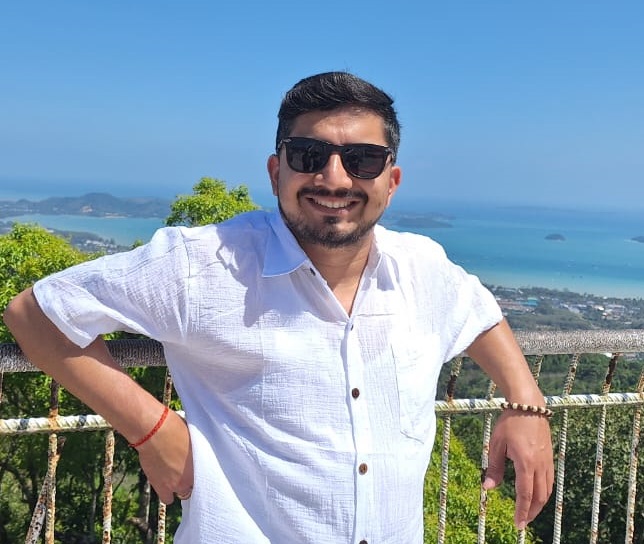
Madhav started working as a porter in 2001 and then moved on to work as a trekking guide. After working in the trekking and tourism industry for eight years, he co-founded Mosaic Adventure in 2009.
Madhav has trekked to most of the trekking destinations in Nepal, including Everest Base Camp Trek, Annapurna Base Camp, Annapurna Circuit Trek, Poon Hill Trek, Jomsom Muktinath Trek, Indigenous Peoples Trek, Langtang Valley Trek, Mardi Himal Trek, and all of the day hikes around Kathmandu.
He has also extensively traveled to other countries such as Australia, the USA, the UK, France, Hong Kong, Japan, China, the Philippines, the UAE, Saudi Arabia, Bahrain, Thailand, Turkey, and India. Madhav is the one who answers most of your questions about trekking and tours and helps to plan your trip by giving a personal touch.

